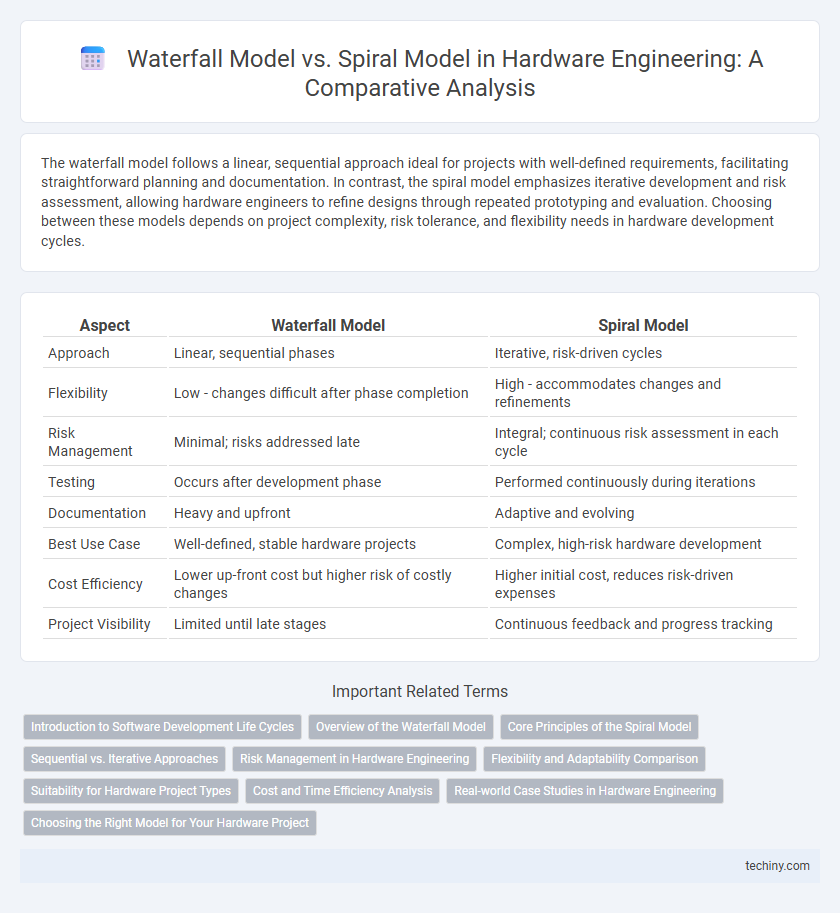The waterfall model follows a linear, sequential approach ideal for projects with well-defined requirements, facilitating straightforward planning and documentation. In contrast, the spiral model emphasizes iterative development and risk assessment, allowing hardware engineers to refine designs through repeated prototyping and evaluation. Choosing between these models depends on project complexity, risk tolerance, and flexibility needs in hardware development cycles.
Table of Comparison
| Aspect | Waterfall Model | Spiral Model |
|---|---|---|
| Approach | Linear, sequential phases | Iterative, risk-driven cycles |
| Flexibility | Low - changes difficult after phase completion | High - accommodates changes and refinements |
| Risk Management | Minimal; risks addressed late | Integral; continuous risk assessment in each cycle |
| Testing | Occurs after development phase | Performed continuously during iterations |
| Documentation | Heavy and upfront | Adaptive and evolving |
| Best Use Case | Well-defined, stable hardware projects | Complex, high-risk hardware development |
| Cost Efficiency | Lower up-front cost but higher risk of costly changes | Higher initial cost, reduces risk-driven expenses |
| Project Visibility | Limited until late stages | Continuous feedback and progress tracking |
Introduction to Software Development Life Cycles
The Waterfall model in hardware engineering follows a linear, sequential approach ideal for projects with well-defined requirements, emphasizing distinct phases such as design, implementation, and testing. In contrast, the Spiral model integrates iterative risk assessment and prototyping, allowing for more flexibility and adaptation to changes throughout the hardware development process. Understanding these Software Development Life Cycles enhances project planning, risk management, and quality assurance in hardware design and implementation.
Overview of the Waterfall Model
The Waterfall Model in hardware engineering follows a linear and sequential design process, emphasizing distinct phases such as requirements analysis, system design, implementation, testing, and maintenance. Its rigid structure ensures thorough documentation and clear milestones, making it suitable for projects with well-defined requirements and minimal expected changes. However, the model's inflexibility can hinder adaptability in hardware development where iterative testing and refinement are often necessary.
Core Principles of the Spiral Model
The Spiral Model in hardware engineering emphasizes iterative development through repeated cycles, allowing for risk assessment and refinement at each phase, contrasting with the linear progression of the Waterfall Model. Core principles include identifying objectives, evaluating risks with prototyping, and planning subsequent iterations to incorporate feedback and mitigate potential failures. This approach enhances flexibility and reduces errors in complex hardware design projects by continuously integrating testing and stakeholder input.
Sequential vs. Iterative Approaches
The Waterfall model follows a sequential approach in hardware engineering, progressing through distinct phases like requirement analysis, design, implementation, and testing without revisiting previous stages, which ensures a structured workflow but limits flexibility. The Spiral model employs an iterative approach, combining design and prototyping in repeated cycles, allowing continuous risk assessment and refinement throughout hardware development. This iteration and risk management make the Spiral model more adaptable for complex hardware projects compared to the rigid sequential nature of the Waterfall model.
Risk Management in Hardware Engineering
The spiral model excels in hardware engineering by integrating iterative risk assessment and mitigation throughout development, enabling early detection of design flaws and hardware failures. Unlike the linear waterfall model, which may overlook risks until late testing stages, the spiral model's cyclical nature supports continuous evaluation of cost, performance, and technical feasibility risks. Effective risk management in hardware projects reduces costly redesigns and enhances reliability by addressing uncertainties in complex hardware development processes.
Flexibility and Adaptability Comparison
The waterfall model offers limited flexibility due to its linear and sequential phases, making it challenging to accommodate changes once a stage is completed. In contrast, the spiral model provides high adaptability through iterative cycles that allow continuous risk assessment and progressive refinement of hardware designs. This iterative approach enhances responsiveness to evolving requirements and unforeseen technical issues in hardware engineering projects.
Suitability for Hardware Project Types
The waterfall model is well-suited for hardware projects with well-defined requirements and stable designs, such as circuit board manufacturing or embedded system development, where sequential phases ensure thorough documentation and testing. The spiral model excels in complex hardware projects involving high risk and frequent changes, like prototype development or innovative device engineering, by incorporating iterative risk assessment and flexibility in design modifications. Choosing between these models depends on project complexity, risk factors, and the need for iterative refinement in hardware engineering processes.
Cost and Time Efficiency Analysis
The waterfall model offers predictable cost and time efficiency through its linear, sequential phases, making it suitable for projects with well-defined requirements in hardware engineering. In contrast, the spiral model incorporates iterative prototyping and risk assessment, often leading to higher initial costs and longer development times but enabling greater flexibility and risk mitigation for complex hardware designs. Evaluating project scope and risk tolerance is critical to selecting the appropriate model that balances cost containment and time-to-market demands effectively.
Real-world Case Studies in Hardware Engineering
Real-world case studies in hardware engineering demonstrate that the waterfall model is effective in projects with well-defined requirements, such as semiconductor manufacturing, where sequential phases ensure design precision and regulatory compliance. Conversely, the spiral model excels in complex, high-risk hardware development like aerospace avionics systems, enabling iterative prototyping and risk analysis that adapt to evolving specifications. These case studies highlight the waterfall model's strength in predictable environments and the spiral model's advantage in managing uncertainty and innovation in hardware projects.
Choosing the Right Model for Your Hardware Project
Selecting the appropriate development model for hardware engineering depends on project complexity and risk factors; the Waterfall model suits well-defined, linear projects with stable requirements, offering clear milestones and documentation. The Spiral model excels in iterative risk assessment and prototyping, ideal for complex hardware designs requiring flexibility and ongoing refinement. Evaluating project scope, resource availability, and risk tolerance ensures the choice of a model that enhances efficiency and product quality.
waterfall model vs spiral model Infographic

 techiny.com
techiny.com